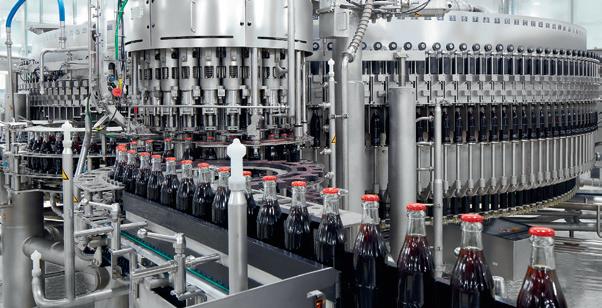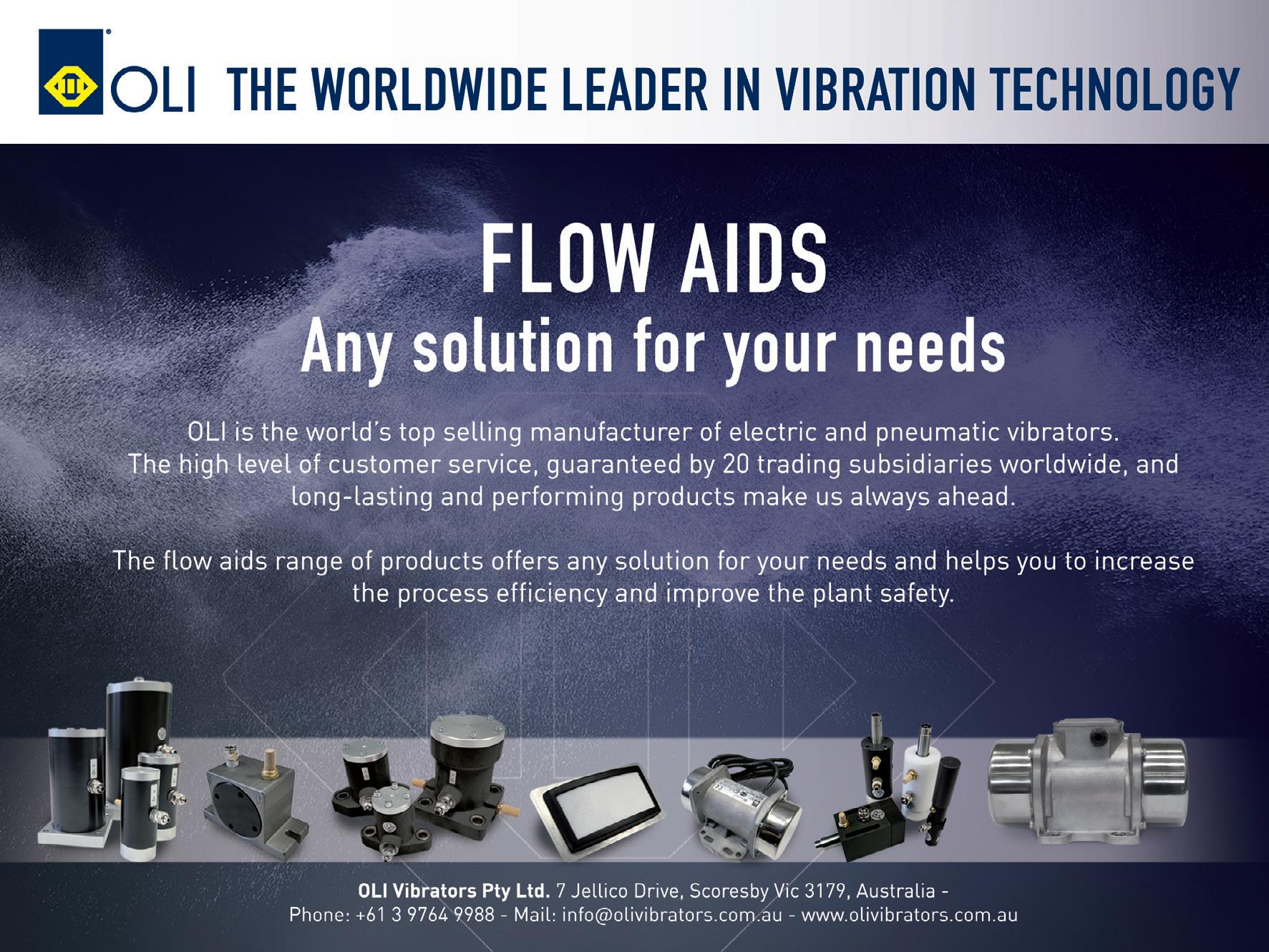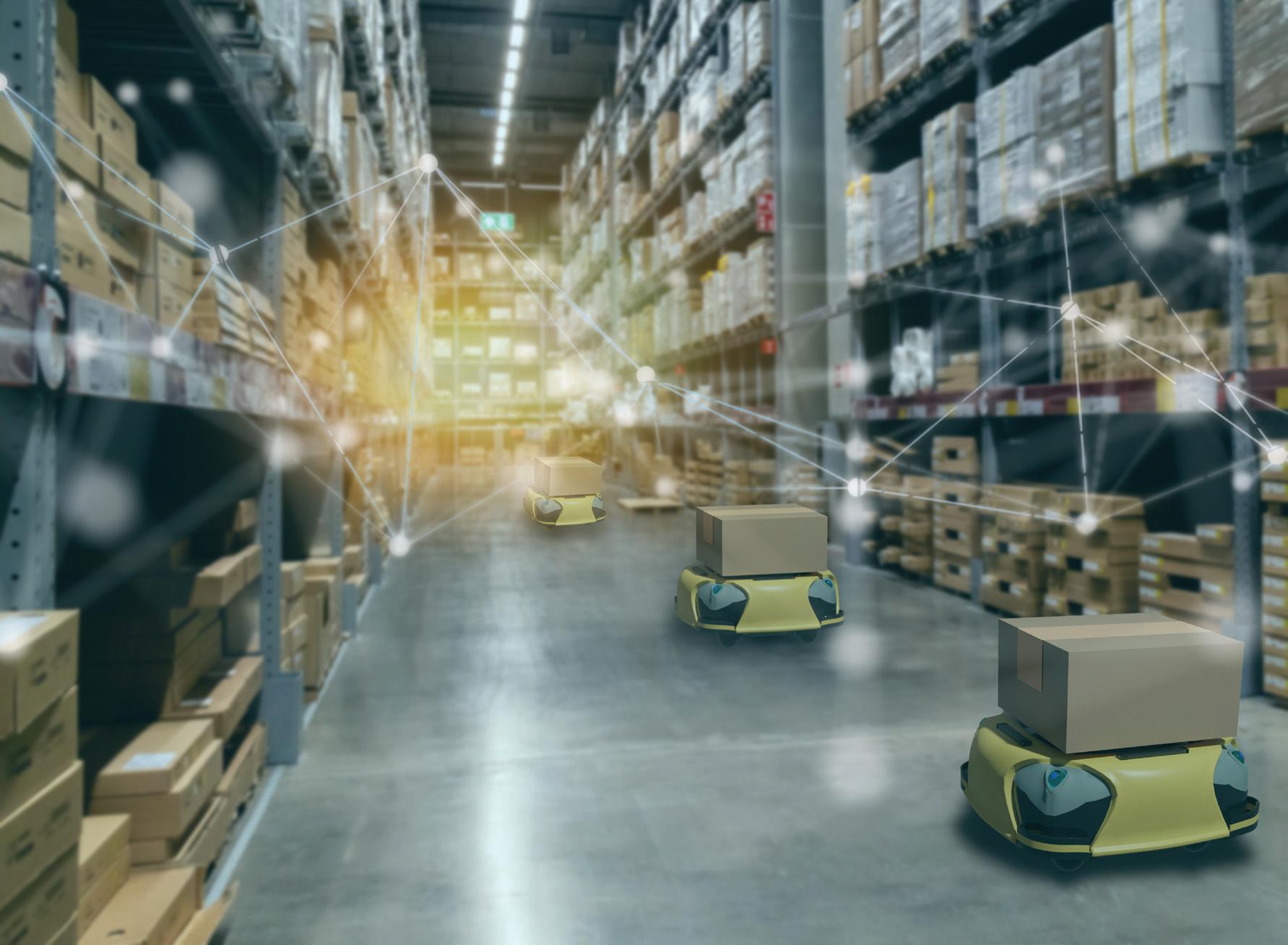
9 minute read
Developing smarter warehouse robots
stock.adobe.com/au/Monopoly919
BULK HANDLING, STORAGE & LOGISTICS
Developing smarter warehouse robots
Researchers from the Rochester Institute of Technology (RIT) are working to develop smarter industrial robots that are designed to be aware of whether or not they have the right of way in busy aisles and can intelligently avoid obstacles, people and other robots. The system integrates smart technologies like LiDAR sensors, and uses artificial intelligence and neural networks to achieve a clearer view of personal space so that robots can behave safely in a decentralised way.
With supply chain challenges brought on by the pandemic and increased demands for e-commerce, technology can provide the support businesses need to improve productivity, efficiency and safety in a warehouse setting.
“This is one area where robotics and autonomous material handling can help,” said Michael Kuhl, professor of industrial and systems engineering in RIT’s Kate Gleason College of Engineering. “Robots can work longer periods of time — not necessarily to replace jobs, but on some of the manual, non-value-added tasks. It means a change of focus of jobs, with people needed to design and maintain fleets of vehicles and robots.”
Kuhl and the project team received a grant for “Effective and efficient driving for material handling”, a one-year, $300,000 project sponsored by The Raymond Corp. It advances earlier work with the company that established task selection and path planning of individual autonomous mobile robots (AMRs).
New work focuses on advanced avoidance and communication strategies for multiple robots and humans in the warehouse environment.
In warehousing operations, there is often a mix of autonomous and human-operated equipment. Avoidance strategies need to be integrated with task options, path planning and recognition of multiple robots able to communicate with one another in real time, and to recognise humans who also will be interacting in the warehouse space.
“We have information about localisation, the different types of sensors that we use within the warehouse to try to identify where the robots are located and the actual movement of the robot,” Kuhl said. “Can they plan to get from the current location to destination safely and efficiently? They can have a short path, but they still need to avoid other robots and people.”
Using deep neural network strategies (types of machine learning techniques), the system components are trained to make specific, sequenced decisions based on common tasks, but also infrequent or unusual actions that might occur in the warehouse environment.
The team is also studying the communication networks within the warehouse — Wi-Fi and cellular network technology functions — as viable solutions. New standards for cellular technologies permit increased individual cellular communication between individual devices, Kuhl explained.
“In terms of people and vehicles interacting, could we take advantage of the sensors of multiple vehicles moving around the warehouse?” he said. “If a vehicle is coming down one path and it sees a person or another vehicle coming out of an aisle, can they communicate and make a decision about what to do next? Who has the right of way?”
The team has found that robots will be able to react in field experiments at Simcona Electronics Corp.
“We needed the real setting to be able to do this work and to move it forward. They provide an extremely valuable resource for us,” Kuhl said.
Reducing inefficiency by tracking pallets
German researchers have developed software that can track and visualise the paths for load carriers such as pallets, crates, racks, containers or tanks. This provides the logistics sector with a way of improving efficiency and reducing downtime.
Developed in the Center for Applied Research on Supply Chain Services at the Fraunhofer Institute for Integrated Circuits IIS, the Logistikbude (German for “logistics convenience store”) software is a web-based offering that helps keep track of load carriers that might otherwise be ignored or left unattended.
The software generates labels for each load carrier and creates a digital file. Returnable load carriers are also equipped with barcodes or sensors. A smartphone app can then be used to record each load carrier with its label before being transported and when they arrive at their destination, with optional updates about their status along the journey possible as well. All this data is synchronised with a server, which can keep track of the locations and statuses of these load carriers as well as their quantities.
Users are then able to access the data and understand when they have been unloaded and are ready to be returned to their home or used for transporting other goods. Any load carriers that have been emptied but not returned will result in an email being sent to the user. Sensors can also be used to record exact location, temperature and humidity to give users more information about their pallets. This means that instead of carriers sitting around unused, they can quickly be reintegrated into the supply chain.
“Until now, many companies have often not even known where their own load carriers are at a given moment, for example. Now they can see where they are at any time and when they will get them back. It makes planning easier. The accelerated circulation ultimately ensures that fewer load carriers have to be purchased overall. This, in turn, contributes to increasing sustainability in the sector,” said Philipp Wrycza, co-founder and CEO of the Fraunhofer spin-off Logistikbude.
“We are pleased not only because Logistikbude has been created at our institute, but also because it represents a valuable tool for making even better use of efficiency potential in the field of transport and logistics,” said Prof. Michael ten Hompel, institute director of Fraunhofer IML.
“With this, Fraunhofer researchers are once again demonstrating their ability to develop practical and helpful solutions for industry.”


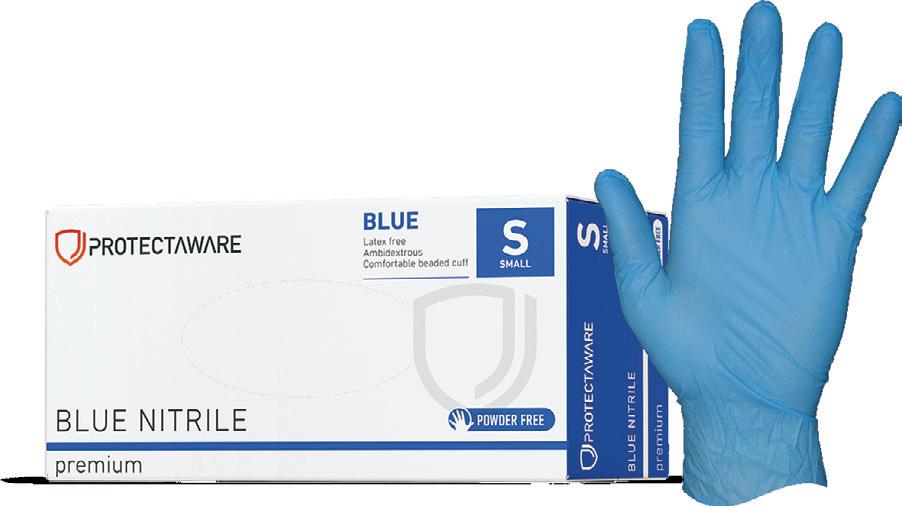
Blue nitrile gloves
Designed for use in the food processing industry, Restock’s Blue Protectaware nitrile gloves provide a close fit for increased tactile sensitivity, grip and precision.
With good puncture and chemical resistance, the gloves have a textured finish for good wet and dry grip.
The glove’s synthetic formulation is designed to reduce hand fatigue, which can help to improve workers’ efficiency for longer.
The nitrile gloves are free from latex, making them suitable for those with skin sensitivities. They also have a roll beaded cuff for easy pull on and off.
The blue gloves are both HACCP certified and ARTG listed.
The company also has a range of alternative coloured nitrile gloves including green, orange, purple, black and clear.
Restock Pty Ltd
www.restock.com.au
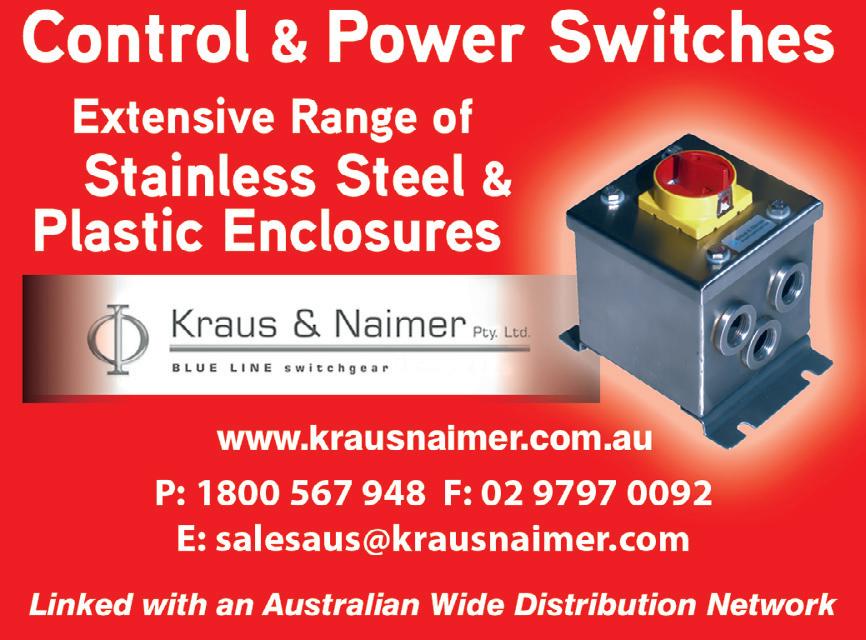

Nut processing feeder line
Eriez vibratory feeding equipment efficiently moves and meters a variety of virgin and processed nuts of any size or shape.
The vibratory feeders are suitable for several applications in the nut industry, particularly when it comes to metering nuts at controlled rates into the next process in the production line.
The feeders specified for nut processing are designed to comply with strict guidelines set forth by Safe Quality Foods (SQF), Good Manufacturing Practices (GMP) and sanitation requirements.
They are commonly used to meter nuts into downstream processing equipment. The vibratory feeder acts as the bulk metering device to provide the nuts at a controllable, easily adjusted rate. Feeders are also used to sprinkle salt, sugar or other seasonings during nut processing. Eriez electromagnetic feeders are offered in various models and designs to meet specific application requirements.
Eriez HD (High Deflection) Vibratory Feeders combine the higher tray deflection, lower frequency advantages of mechanical feeders with the trouble-free service and adjustability of electromagnetic feeders. When screening is required to remove undersize material such as excess salt or oversize materials such as agglomerated coated nuts, the higher tray deflection of HD models is suitable. HD Feeders are commonly used in nut processing applications when gentle feeding is critical. Softer nuts, such as walnuts, can be handled by this model.
Eriez HS (High Speed) Vibratory Feeders are specifically designed for fast feed rates and offer fast start-up and shutdown, making this model suitable for nut packaging applications. They are suitable for use in conjunction with weigh scale and packaging machines. The compact and functional units can be installed easily in small spaces.
Eriez Model C Feeders feed and control material flows ranging from a kg per minute to many tons per hour. These units have no rotating parts to wear out and feature AC-operated, electromagnetic drives which consume up to 60% less energy than competitive DC drives.
One of the primary benefits of vibratory feeders in the nut processing industry is the simple and clean construction of the feeder tray. The trays are designed to be easily and quickly wiped down or washed out for product changeover or sanitation protocols.
Eriez Magnetics Pty Ltd
www.eriez.com.au
Optimising a returnable Coca-Cola bottle system
A Coca-Cola plant in Mannheim, Germany, has installed a returnable glass bottle line from KHS to boost its recycling abilities. The automated line takes bottles, cleans and rinses them, and then sorts them out to be reused. The system fills six bottle formats: four in 200 mL and two in 330 mL sizes, with different use cases for the different sizes.
“The smaller sizes are primarily destined for the hospitality trade, where the packaging has to be a bit more impressive than for retail,” said the plant manager, Christopher Bee. “This is why the Coca-Cola, Fanta, Sprite and mezzo mix brands on this line have their own respective bottle designs. We process two formats for the bigger containers that are also sold in the retail trade: what’s known as the contour bottle for products in the Coca-Cola family and our green multibottle for Fanta, Sprite and mezzo mix.”
The sorting and washing are all done automatically and there is no need for the cleaned bottles to be sent to a warehouse before being refilled. Instead they are sent right off to the filling line.
The system has only one manual element: prior to being sorted, crates of empty bottles are scanned by the sorting system and it is here where any obstacles like paper cups or film must be removed by hand. Otherwise the system operates in a wholly autonomous manner. “The smaller bottles are set down on a different conveyor where they’re separated and guided to different lanes with the help of camera systems and pushers,” Bee said. “Here, we aim to manipulate the containers as little as possible: in other words, to ensure that they have very little contact with the machine. In this way, we can keep the risk of something falling over at such high speed to a minimum.”
The line’s bottle washer saves around 40% on energy and water usage compared to previous generation systems. Energy is saved elsewhere too, with its carriers having a reduced weight and more carefully placed openings to make rinsing bottles easier and more efficient. Finally, the spraying system uses less pressure during downtime and thus reduces electricity consumption by up to 80%.
The plant is now operational and processes 60,000 bottles an hour. KHS Pacific Pty Ltd www.khs.com
